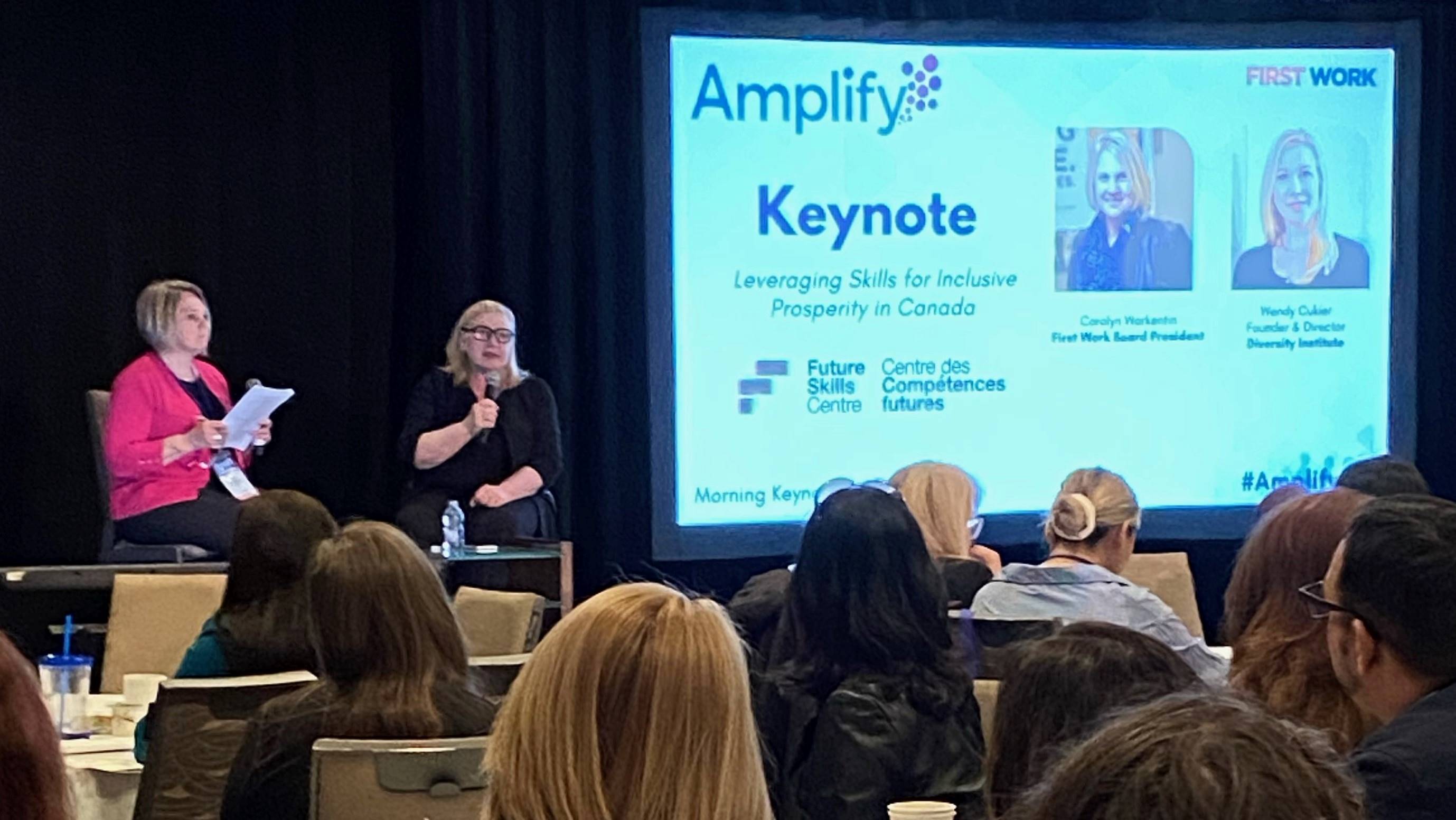Creative solutions are needed to close the gap between equity-deserving groups and the Canadian labour market

Carolyn Warkentin (left) sits with Wendy Cukier on stage during the keynote panel at the Amplify Leadership Summit in Toronto on April 17, 2023.
On April 17, 2023, at the Amplify Leadership Summit (external link) , Carolyn Warkentin, executive director at South Essex Community Council (external link) , hosted a keynote panel with Wendy Cukier, founder and academic director of the Diversity Institute (DI) and a research lead of the Future Skills Centre (external link) (FSC). Topics discussed included Canadian labour market trends and critical needs to newcomer integration and the barriers newcomers face. More than 130 people attended the in-person event that also dug into ways to ensure better use of the talents and skills of newcomers to Canada.
During the discussion, Warkentin pointed to an Immigration, Refugees and Citizenship Canada study (external link) that found immigration accounts for almost 100% of Canada’s labour force growth and by 2032 is projected to account for 100% of Canada’s population growth. She noted that in Ontario, a lot more grant funding and subsidies have been flowing to employers to increase the talent pipeline for economic growth. What is the employer's role in ensuring that we build a sustainable and diverse talent pipeline that aids in retention and career growth, she asked.
Cukier highlighted that immigration is a competitive issue for Canada regarding international talent. “The concern is not a gap in population, but a lack of recognizing skills and the full potential of newcomers,” Cukier said. “While employers are allowing equity-deserving groups to enter the workforce, they aren’t providing them with the tools for them to grow and prosper,” she added.
“ (PDF file) Diversity Institute research is showing how important wraparound supports are in allowing immigrants to complete employment and skills programs,” Cukier said. “The Diversity Institute is working with partners like the FSC on initiatives to provide these kinds of tools, highlighting a collaboration with the Ontario Chamber of Commerce (external link) to create a learning management system that’s accessible to all their members. It will provide different types of equity diversity and inclusion training to employers, alongside other business skills.”
“It’s important to ensure that EDI in the Canadian labour market is not just optics focused,” she added. “It needs to be embedded into the core of the organization.”
Switching the focus to Canada’s immigration system, Warkentin then asked how we can improve our immigration system to ensure it meets our employment needs.
Cukier pointed to (PDF file) a study that looked at the Australian system because the countries are similarly dependent on immigrants and international students to meet employment needs. The study found that in Australia, more than 75 % of newcomer professionals earn 90% of their sector’s average wages. In Canada, the number of newcomer professionals earning 90% of their sector’s average wages decreases to 50%.
“In other words, immigrants in Australia are more likely to be successful from an economic standpoint,” Cukier said.
“It’s important to ensure that EDI in the Canadian labour market is not just optics focused. It needs to be embedded into the core of the organization.”
Cukier said that while Australia has never enjoyed Canada’s reputation for tolerance and inclusion, it has leapfrogged over Canada in terms of policy innovation.
“Australia has been innovative in using research to improve selection methods and in working closely with employers. It has also worked to ease the recognition of international credentials, provides occupation-specific bridging courses combined with industry internships and regularly updates its methods of skills assessments,” she said.
Warkentin followed up with a question on approach, “as we seek to increase immigration, how do we ensure our biases are not unintentionally inhibiting our growth by leaving people behind?”
“Employers are focused on profit and their business needs,” Cukier said. “And, the approach is not to try to adjust their moral compass and force them to hire immigrants. We must aim to understand what it is they are needing and come up with creative ways to diversify the workforce while ensuring both parties are supported.”
“Newcomers bring unique skills and assets to the workforce connected to their immigration experience, like learning a new language, starting over in a new country and living far away from the people and life they know,” Cukier added.
Cukier noted (PDF file) DI research (external link) has found newcomers are more entrepreneurial than Canadians as a whole. Encouraging newcomer entrepreneurship is a viable path to integration through programs like the Newcomer Entrepreneurship Hub (external link) . The Scadding Court Community Centre’s (external link) Newcomer Services Program or St. Stephen’s Community House (external link) are also good examples to look to because they offer counseling, networking, language instruction, child care support and cultural-competency training, along with assistance navigating the employment and settlement services ecosystem.
Cukier closed the discussion advising that, “these are real-life experiences that can’t and should not go unnoticed, and employers need to be asking the right questions to receive a holistic understanding of who the person is. “Having empathy with the experiences of newcomers is essential for all programs and people working in this ecosystem.”
